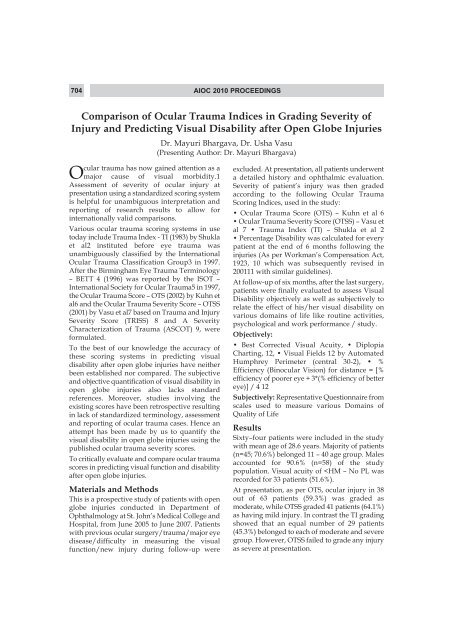Comparison of Ocular Trauma Indices in Grading Severity of Injury ...
Comparison of Ocular Trauma Indices in Grading Severity of Injury ...
Comparison of Ocular Trauma Indices in Grading Severity of Injury ...
You also want an ePaper? Increase the reach of your titles
YUMPU automatically turns print PDFs into web optimized ePapers that Google loves.
704 AIOC 2010 PROCEEDINGS<strong>Comparison</strong> <strong>of</strong> <strong>Ocular</strong> <strong>Trauma</strong> <strong>Indices</strong> <strong>in</strong> Grad<strong>in</strong>g <strong>Severity</strong> <strong>of</strong><strong>Injury</strong> and Predict<strong>in</strong>g Visual Disability after Open Globe Injuries<strong>Ocular</strong> trauma has now ga<strong>in</strong>ed attention as amajor cause <strong>of</strong> visual morbidity.1Assessment <strong>of</strong> severity <strong>of</strong> ocular <strong>in</strong>jury atpresentation us<strong>in</strong>g a standardized scor<strong>in</strong>g systemis helpful for unambiguous <strong>in</strong>terpretation andreport<strong>in</strong>g <strong>of</strong> research results to allow for<strong>in</strong>ternationally valid comparisons.Various ocular trauma scor<strong>in</strong>g systems <strong>in</strong> usetoday <strong>in</strong>clude <strong>Trauma</strong> Index - TI (1983) by Shuklaet al2 <strong>in</strong>stituted before eye trauma wasunambiguously classified by the International<strong>Ocular</strong> <strong>Trauma</strong> Classification Group3 <strong>in</strong> 1997.After the Birm<strong>in</strong>gham Eye <strong>Trauma</strong> Term<strong>in</strong>ology– BETT 4 (1996) was reported by the ISOT –International Society for <strong>Ocular</strong> <strong>Trauma</strong>5 <strong>in</strong> 1997,the <strong>Ocular</strong> <strong>Trauma</strong> Score – OTS (2002) by Kuhn etal6 and the <strong>Ocular</strong> <strong>Trauma</strong> <strong>Severity</strong> Score – OTSS(2001) by Vasu et al7 based on <strong>Trauma</strong> and <strong>Injury</strong><strong>Severity</strong> Score (TRISS) 8 and A <strong>Severity</strong>Characterization <strong>of</strong> <strong>Trauma</strong> (ASCOT) 9, wereformulated.To the best <strong>of</strong> our knowledge the accuracy <strong>of</strong>these scor<strong>in</strong>g systems <strong>in</strong> predict<strong>in</strong>g visualdisability after open globe <strong>in</strong>juries have neitherbeen established nor compared. The subjectiveand objective quantification <strong>of</strong> visual disability <strong>in</strong>open globe <strong>in</strong>juries also lacks standardreferences. Moreover, studies <strong>in</strong>volv<strong>in</strong>g theexist<strong>in</strong>g scores have been retrospective result<strong>in</strong>g<strong>in</strong> lack <strong>of</strong> standardized term<strong>in</strong>ology, assessmentand report<strong>in</strong>g <strong>of</strong> ocular trauma cases. Hence anattempt has been made by us to quantify thevisual disability <strong>in</strong> open globe <strong>in</strong>juries us<strong>in</strong>g thepublished ocular trauma severity scores.To critically evaluate and compare ocular traumascores <strong>in</strong> predict<strong>in</strong>g visual function and disabilityafter open globe <strong>in</strong>juries.Materials and MethodsThis is a prospective study <strong>of</strong> patients with openglobe <strong>in</strong>juries conducted <strong>in</strong> Department <strong>of</strong>Ophthalmology at St. John’s Medical College andHospital, from June 2005 to June 2007. Patientswith previous ocular surgery/trauma/major eyedisease/difficulty <strong>in</strong> measur<strong>in</strong>g the visualfunction/new <strong>in</strong>jury dur<strong>in</strong>g follow-up wereDr. Mayuri Bhargava, Dr. Usha Vasu(Present<strong>in</strong>g Author: Dr. Mayuri Bhargava)excluded. At presentation, all patients underwenta detailed history and ophthalmic evaluation.<strong>Severity</strong> <strong>of</strong> patient’s <strong>in</strong>jury was then gradedaccord<strong>in</strong>g to the follow<strong>in</strong>g <strong>Ocular</strong> <strong>Trauma</strong>Scor<strong>in</strong>g <strong>Indices</strong>, used <strong>in</strong> the study:• <strong>Ocular</strong> <strong>Trauma</strong> Score (OTS) – Kuhn et al 6• <strong>Ocular</strong> <strong>Trauma</strong> <strong>Severity</strong> Score (OTSS) – Vasu etal 7 • <strong>Trauma</strong> Index (TI) – Shukla et al 2• Percentage Disability was calculated for everypatient at the end <strong>of</strong> 6 months follow<strong>in</strong>g the<strong>in</strong>juries (As per Workman’s Compensation Act,1923, 10 which was subsequently revised <strong>in</strong>200111 with similar guidel<strong>in</strong>es).At follow-up <strong>of</strong> six months, after the last surgery,patients were f<strong>in</strong>ally evaluated to assess VisualDisability objectively as well as subjectively torelate the effect <strong>of</strong> his/her visual disability onvarious doma<strong>in</strong>s <strong>of</strong> life like rout<strong>in</strong>e activities,psychological and work performance / study.Objectively:• Best Corrected Visual Acuity, • DiplopiaChart<strong>in</strong>g, 12, • Visual Fields 12 by AutomatedHumphrey Perimeter (central 30-2), • %Efficiency (B<strong>in</strong>ocular Vision) for distance = [%efficiency <strong>of</strong> poorer eye + 3*(% efficiency <strong>of</strong> bettereye)] / 4 12Subjectively: Representative Questionnaire fromscales used to measure various Doma<strong>in</strong>s <strong>of</strong>Quality <strong>of</strong> LifeResultsSixty–four patients were <strong>in</strong>cluded <strong>in</strong> the studywith mean age <strong>of</strong> 28.6 years. Majority <strong>of</strong> patients(n=45; 70.6%) belonged 11 – 40 age group. Malesaccounted for 90.6% (n=58) <strong>of</strong> the studypopulation. Visual acuity <strong>of</strong>
TRAUMA SESSION705Visual acuity recorded at 6 months after the lastsurgery was most commonly between < HM –No PL <strong>in</strong> 27 patients (42.2%). 30 out <strong>of</strong> 64 patients(46.8%) had poor b<strong>in</strong>ocular vision at 6 monthsfollow-up. At the end <strong>of</strong> follow – up period, only14 patients (29.1%) had a severe visual disabilityobjectively, while 44 patients (68.8%) had onlymild objective visual disability. Among the 24patients with good b<strong>in</strong>ocular vision at 6 months,23 patients (95.8%) had mild objective disability.With respect to subjective disability, 40 patients(62.5%) were only mildly restricted <strong>in</strong> theirrout<strong>in</strong>e activities, while 29 patients (45.3%), werefound to be moderately psychologically affectedand were anxious, depressed and emotionallydisturbed at the end <strong>of</strong> 6 months. Well – be<strong>in</strong>gscale with respect to life satisfaction, general well– be<strong>in</strong>g and positive attitude was found to beonly mildly affected <strong>in</strong> most <strong>of</strong> the patients, 37(57.8 %), at the end <strong>of</strong> 6 months. Work / studyperformance was found to have suffered mildloss <strong>in</strong> 23 patients (35.9%), at the end <strong>of</strong> 6 months.19 out <strong>of</strong> 24 patients (79.1%) with good b<strong>in</strong>ocularvision had mild total subjective disability at 6months.OTS correlation with visual rega<strong>in</strong> at 6 monthswas found to be better for mild and moderate<strong>in</strong>juries while that <strong>of</strong> OTSS showed bettercorrelation for severe <strong>in</strong>juries. However, acorrelation between TI and various grades <strong>of</strong>visual rega<strong>in</strong> could not be obta<strong>in</strong>ed.With respect to correlation <strong>of</strong> <strong>in</strong>jury severity at1. Parver L. Eye trauma. The neglected disorder. ArchOphthalmol; 104(10):1452–3.2. B. Shukla and B<strong>in</strong>od Khanna. <strong>Trauma</strong> Index – asystem <strong>of</strong> evaluation <strong>of</strong> ocular damage due totrauma. Indian Journal <strong>of</strong> Ophthalmology, July 1983,31:439–41.3. Pieramici DJ, Sternberg P Jr, Aaberg TM Sr, BridgesWZ Jr, Capone A Jr, Cardillo JA, de Juan E Jr, KuhnF, Meredith TA, Mieler WF, Olsen TW, RubsamenP, Stout T.”A system for classify<strong>in</strong>g mechanical<strong>in</strong>juries <strong>of</strong> the eye (globe). The <strong>Ocular</strong> <strong>Trauma</strong>Classification Group.” American Journal <strong>of</strong>Ophthalmology. 1997 Jun;123(6):820-31.4. Kuhn F, Morris R, Witherspoon CD. Birm<strong>in</strong>ghamEye <strong>Trauma</strong> Term<strong>in</strong>ology (BETT): Term<strong>in</strong>ology andclassification <strong>of</strong> mechanical eye <strong>in</strong>juries.”Ophthalmology Cl<strong>in</strong>ics <strong>of</strong> North America. 2002 Jun;15(2):139–43.5. Kuhn.F, Morris R, Witherspoon CD, Heimann K,Jeffers JB, Treister G. A standardized classification<strong>of</strong> ocular trauma. Ophthalmology. 1996 Feb;103(2):Referencespresentation with objective disability at 6months, <strong>in</strong> OTS it is better for mild and moderate<strong>in</strong>juries while OTSS correlates better formoderate and severe <strong>in</strong>juries. TI does not reallyrelate the severity <strong>of</strong> <strong>in</strong>jury at presentation withvisual disability at 6 months well.On correlat<strong>in</strong>g <strong>in</strong>jury severity at presentationwith subjective disability at 6 months, OTSshowed statistically significant correlation (P
706 AIOC 2010 PROCEEDINGSDisabilities Act, 1965, 1st June 2001.12. Council on Industrial Health, A.M.A.:Estimation <strong>of</strong> loss <strong>of</strong> visual efficiency, Arch. Indust.H. 1955;12:439.13. Schipper J, Landau K, Hornung r. Evaluation <strong>of</strong>visual field defects, motility disorders and diplopiawith<strong>in</strong> the scope <strong>of</strong> accident <strong>in</strong>surance law. Kl<strong>in</strong>Monatsbl Augenheikd. 1993 May; 202(5):382-5.
















